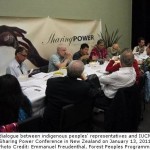
Bonn – Parties to the United Nations Framework Convention on Climate Change (UNFCCC) have agreed the selection of the forty members who will be entrusted with the task of designing the Green Climate Fund, the new institution which will manage long-term finance mobilized to enable developing countries to address climate change.
The selection of this Transitional Committee, which will prepare operational specifications for the fund in time for approval by the next UN Climate Conference in Durban, in December, was one of the first scheduled tasks for 2011 under the international Cancun Agreements.
The high level of interest among governments in contributing to the design process is a demonstration of the great interest among Parties in the Green Climate Fund. Parties have put forward experienced and respected individuals from the fields of finance and climate change, UNFCCC Executive Secretary Christiana Figueres said on Friday, April 15.
The transparent, predictable and adequate provision of finance in the long-term is essential to ensure that the poor and vulnerable can build themselves a sustainable future in the face of climate change, she said.
The Transitional Committee will have its first meeting in Mexico City on April 28 and 29. The meeting will be open to observers and the proceedings will be web cast on the UNFCCC website. A list of members and information on their background can be found on the UNFCCC website.
The Green Fund is being launched in the broad context of long-term financial support agreed at Cancun, under which industrialized countries committed to a goal of mobilizing jointly USD 100 billion per year by 2020. These funds would be raised from a mix of public and private sources and directly linked to meaningful mitigation actions and transparency on implementation.
The Cancun Agreements, reached on 11 December in Cancun, Mexico, at the 2010 United Nations Climate Change Conference, are a set of significant decisions by the international community to address the long-term challenge of climate change collectively and comprehensively over time and to take concrete action now to speed up the global response.
An overview of these agreements and an overview of the Green Climate Fund can be found on the UNFCCC website.
The Green Climate Fund was only one of several new institutions which Cancun agreed to launch to speed up international action. The others included a Technology Mechanism to get clean technologies to the right place, at the right time and to best effect, and an Adaptation Framework to boost international cooperation to help developing countries protect themselves from the impacts of climate change.
About the UNFCCC
With 194 Parties, the United Nations Framework Convention on Climate Change (UNFCCC) has near universal membership and is the parent treaty of the 1997 Kyoto Protocol. The Kyoto Protocol has been ratified by 192 of the UNFCCC Parties. Under the Protocol, 37 States, consisting of highly industrialized countries and countries undergoing the process of transition to a market economy, have legally binding emission limitation and reduction commitments. The ultimate objective of both treaties is to stabilize greenhouse gas concentrations in the atmosphere at a level that will prevent dangerous human interference with the climate system. For more information, visit http://unfccc.int/.
Source: UNFCCC.












